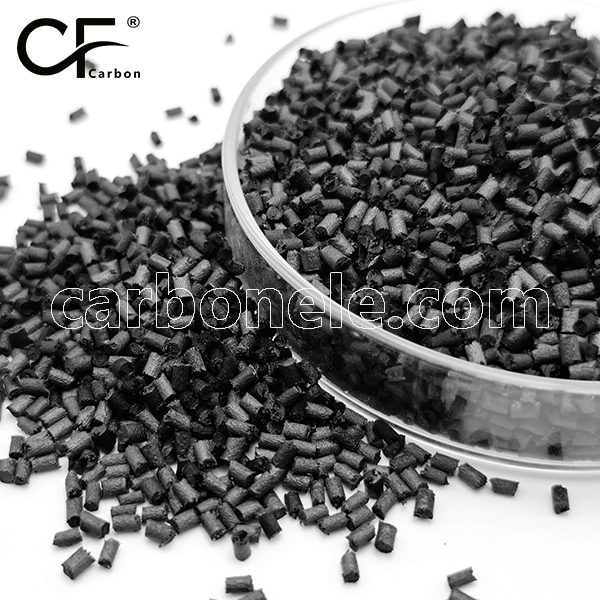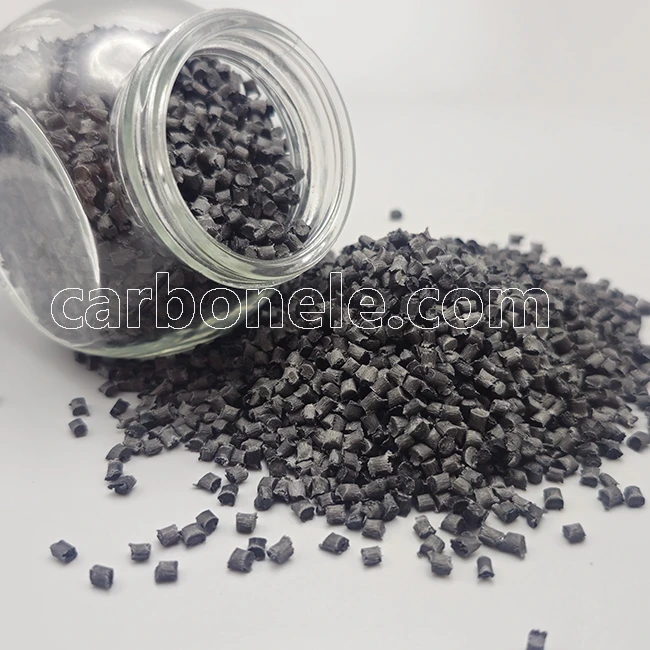
Carbon Fiber Filled Polypropylene PP 30 CF Pellets
The main performance characteristics of Carbon Fiber Filled Polypropylene PP 30 CF Pellets include enhanced mechanical properties (strength and rigidity), improved thermal properties (heat resistance and reduced expansion), conductivity enhancement, and weight reduction for various applications.
- Manufacturer: Carbon New Material
- OEM/ODM: Acceptable
- Color: Black
- Free samples: ≤10kg
- MOQ: 100kg
- Port: Xiamen
- Model: PEEK-CF-BCA2
- Fillers: Carbon fiber
Carbon Fiber Filled Polypropylene PP 30 CF Pellets
– Composition
– Polypropylene (PP):Acting as the base material, it makes up a significant portion within the whole composite material, roughly 70%. Polypropylene is a thermoplastic resin that is formed by the polymerization of propylene. It possesses characteristics like being lightweight, non-toxic, odorless, and having good resistance to chemical substances. Moreover, it is relatively inexpensive and widely accessible.
– Carbon Fiber (CF):With a content of 30%, it serves as the reinforcing element. Carbon fiber is a high-strength and highly rigid fibrous substance composed of carbon atoms. It exhibits excellent mechanical attributes such as high strength, high modulus, and low density. Its strength is several times greater than that of steel, while its density is only a fraction of that of steel.
– Main Performance Characteristics
– Mechanical Properties:
– Strength Augmentation:The incorporation of carbon fiber markedly boosts the strength of the material. In comparison to pure polypropylene, the strength of polypropylene filled with 30% carbon fiber is considerably enhanced, allowing PP 30 CF to bear larger loads. It is apt for application scenarios where there are high demands on material strength, like automotive components and mechanical structural parts.
– Rigidity Enhancement:Carbon fiber has a high level of rigidity. Once filled into polypropylene, PP 30 CF intensifies the rigidity and hardness of the material, making it less susceptible to deformation and endowing it with better dimensional stability.
– Thermal Properties:
– Heat Resistance Improvement:Polypropylene by itself has a certain degree of heat resistance and can be utilized above 100°C. Carbon fiber has excellent thermal stability and can maintain good performance even at high temperatures. Consequently, the heat resistance of polypropylene filled with carbon fiber is further enhanced, enabling it to be used in higher temperature environments.
– Reduction of Thermal Expansion Coefficient:Carbon fiber has a low thermal expansion coefficient. When combined with polypropylene, it lessens the overall thermal expansion coefficient of the material, causing its dimensional changes to be smaller during temperature fluctuations. This improves the dimensional stability and reliability of the material and is suitable for applications with high requirements for dimensional accuracy, such as electronic device casings.
– Other Properties:
– Conductivity Enhancement:Carbon fiber has good electrical conductivity. A small amount of carbon fiber can confer a certain level of conductivity on the originally insulating polypropylene, which can be applied in situations where conductivity or anti-static properties are required, such as electronic packaging and anti-static materials.
– Weight Reduction Outcome:Although carbon fiber is added, due to its low density, the overall density of the material is still relatively low. On the premise of ensuring strength and performance, PP 30 CF accomplishes lightweighting, which helps to reduce the weight and energy consumption of products, meeting the demands of modern industry for lightweight materials.
If you’d like to learn more on PP 30 CF plastic granules (PP-CF-BCA3) or other CFRTPs, please click here or directly contact Carbon New Material.
Contact Us
If you want to obtain information such as product specifications, performance, and price, choose a suitable product according to your own needs. Meanwhile, you can ask the manufacturer to provide samples for testing to ensure that the material meets your usage requirements. If you are interested in purchasing this composite material, please contact the manufacturer Carbon (Xiamen) New Material directly.

Frequently Asked Questions
Carbon (Xiamen) New Material Co., Ltd. aims to provide buyers with "one-stop" worry-free high-quality services. Here you can find all information about carbon fiber engineering plastics. If you still have questions, please send us an email for consultation!
-
How can I contact the manufacturer of a product that interests me?
When you find a product you are interested in, you can contact the manufacturer directly by sending an email and we will get back to you as soon as possible.
-
How do I find the products that interest me?
All you need to do is enter the keyword, product name in the search window and press the Enter key on your keyboard. Your search results page will then be displayed. You can also search within the product category pages on the home page. Each category is divided into subcategories, allowing you to refine your search and find products that interest you.
-
Where will I find a buying guide?
Please contact our after-sales service directly and we will provide you with a comprehensive operating guide.
-
What are CF Reinforced Thermoplastic Composites?
CF Reinforced Thermoplastic Composites are materials where carbon fibers are incorporated into a thermoplastic matrix. They combine the strength and stiffness of carbon fibers with the processability and recyclability of thermoplastics. For instance, they are used in automotive parts like bumper beams.
-
What are the benefits of CF Reinforced Thermoplastic Composites over traditional composites?
The key benefits include faster production cycles, easier recyclability, and better impact resistance. They also offer design flexibility. An example is in the manufacturing of consumer electronics casings where complex shapes can be achieved more easily.
-
How are CF Reinforced Thermoplastic Composites processed?
Common processing methods include injection molding, extrusion, and compression molding. Injection molding is widely used for mass production. For example, in the production of small components for the medical industry.
-
What industries use CF Reinforced Thermoplastic Composites?
They are utilized in aerospace, automotive, medical, and sports equipment industries. In aerospace, they can be found in interior components. In the medical field, they might be used in prosthetics.
-
How does the carbon fiber content affect the properties of the composites?
Higher carbon fiber content generally leads to increased strength and stiffness but may reduce ductility. A moderate content is often balanced for specific applications. For example, a higher content might be preferred in structural parts of a race car.
-
What are the challenges in using CF Reinforced Thermoplastic Composites?
Challenges include higher material costs, complex processing equipment requirements, and ensuring uniform fiber dispersion. Issues with adhesion between the fibers and the matrix can also arise. An example is in achieving consistent quality in large-scale production.

























